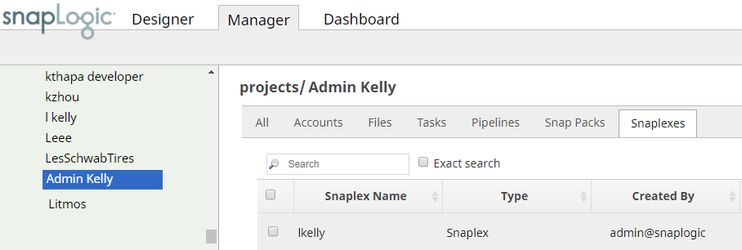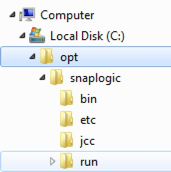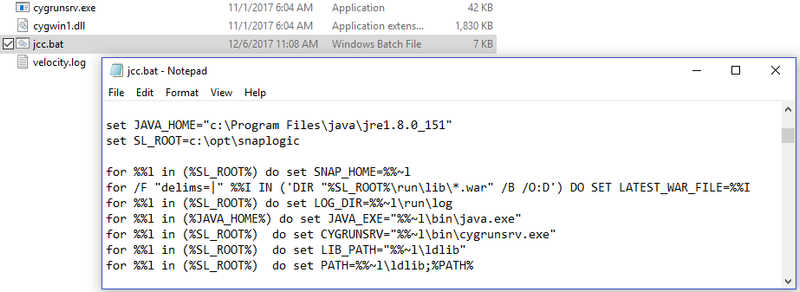In this Article
Prerequisites
Required Ports
| Function | Port | Protocol | Application |
|---|---|---|---|
| JCC node's HTTPS | 8081 | TCP | McAfee Framework Service (FrameworkService.exe) |
| FeedMaster node's HTTPS | 8084 | TCP | Apache Tomcat server (Netbeans JSP servlets) |
| FeedMaster node's broker | 8089 | TCP | Splunk web-interface |
If another application already uses one of the JCC ports used by SnapLogic, the JCC nodes do not complete a full start cycle. The workaround is to override the default port by assigning the following entries in the global.properties file to ports which are available:
- For http port: jcc.jetty_port = 8x89
For https port: jcc.cc_secure_port = 8x81
Java Runtime Environment (JRE)
You must install the Java Runtime Environment (JRE) before installing your on-premise Snaplex. The SnapLogic platform supports Java 11. We recommend you use the latest patch version available of Java 11 for your Windows environment. To update your Snaplex to the Java 11, see Upgrading Your Groundplex to Java 11.
JDK11 Distribution
Only OpenJDK 11 is certified by SnapLogic. Since no other JDK 11 distribution is currently certified by SnapLogic, we recommend that you only use OpenJDK 11 when upgrading to Java 11.
File Name Length
File names generated by SnapLogic for suggest data can be longer than 260 characters long. We recommended that you configure the Snaplex node to allow longer file paths. See Maximum Path Length Limitation - Win32 apps for details.
Installing the Snaplex
If the Snaplex is already installed on the machine, the old installation needs to be stopped before the installation can be done at a new location.
To stop the old installation, run bin\jcc.bat stop. If the Snaplex was installed as a service, the service needs to be removed by running bin\jcc.bat remove_service.
To install Snaplex on-premises on Windows:
- As an Org admin, log into SnapLogic Manager.
- Under Project Spaces on the left, locate the project where you want to create your Groundplex (or the global shared project), then select the Snaplexes tab on the right.
- Click the Create + button and complete the Create dialog (later known as the Update Snaplex dialog).
- Once completed, the dialog reopens to the Downloads panel.
- Download the Windows ZIP file and the configuration file onto the Windows machine where you want the Groundplex installed.
- Create the directory
\opton your server in the root of the C: drive. - Unzip the zip file to
c:\opt. This will create a directoryc:\opt\snaplogicand a directory structure as follows: Check your Windows environment to see if you have a version 11 of Java.
Version of Java
Make sure the version of Java that you are installing matches the type (32-bit or 64-bit) of Windows machine.
Do this by executing the commandjava -versionin a command window.- If the version of Java is less than JRE 11, download the Windows JRE and install the JRE at
c:\opt\java. - If JRE 11 is already available on the machine, the existing installation can be used. Use Notepad to edit the file
c:\opt\Snaplogic\bin\jcc.batand change the entry for the JAVA_HOME environment variable to the location of the existing installation, putting double quotes around the value. - If the host machine is configured for JRE auto-update, then each time a JRE update occurs, the older JRE installation is deleted by default. As a result, the Snaplex fails to start after the JRE update. To avoid this issue, use the static installation feature of the JRE installer.
To do a static install:- Add the
STATIC=1option when running the JRE installer from the command line or from the Run dialog. - When the JRE auto-update occurs, uncheck the uninstall option for older JRE installations. This prevents the older installation from being removed.
- Add the
- If the version of Java is less than JRE 11, download the Windows JRE and install the JRE at
- After the software has been installed, place the downloaded configuration file in the \
opt\snaplogic\etcdirectory and make sure the file name ends with.slpropz. - From the command prompt, change to the
\opt\snaplogic\bindirectory. You may start the node by running the command:jcc.bat start
Alternatively, to install the Snaplex as a Windows service, run the following command as an administrator:jcc.bat install_service
Then, go to the Windows Control Panel services, to view the entry for the SnapLogic Snaplex, and start the service from Tools in the Services window. To establish if the process started, run the command:
jcc.bat status. The state should beRunning.To verify the Snaplex has started, visit https://elastic.snaplogic.com/sl/dashboard.html#Health
The newly installed node should show up in the list of nodes for the Snaplex.
Upgrading on Windows
By default the JCC will automatically update itself. To disable this, apply the following setting in c:\opt\snaplogic\etc\global.properties:
jcc.enable_auto_download = False
The autoupgrade process updates the binaries for the JCC process. When running as a service, doing a service restart causes the Monitor process to start with the old binaries files.
To update the service to use the latest binaries, run the command:c:\opt\snaplogic\bin\jcc.bat update_service
Troubleshooting Installation
- Are you starting the JCC node as an Administrator?
- Is the c
:\opt\snaplogic\run\logfolder full? If it is full, delete the logs and try restarting again. - Is JAVA_HOME set correctly?







